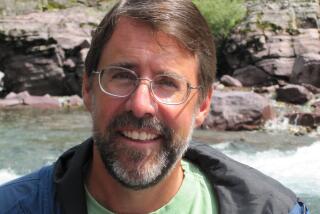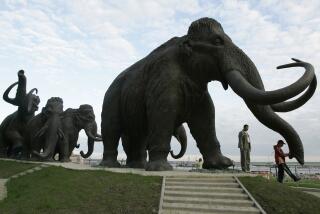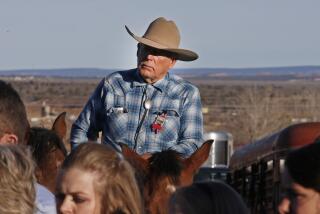Once-Endangered Buffaloes Stampede to Revitalization :...
- Share via
YELLOWSTONE NATIONAL PARK, Wyo. — If his grand vision comes true, a Lakota Indian named Fred DuBray will soon be able to plan the 20th-Century’s greatest wild buffalo roundup, cutting Yellowstone’s 4,000-animal herd in half.
“This hunt will be a little different,” DuBray said. “We’ll do it to save their lives.”
Severe overcrowding in recent years has driven many of the park’s buffaloes onto neighboring cattle ranches. In 1994, Montana game wardens shot about 400 of them to eliminate any chance that they could infect domestic cattle with brucellosis, a deadly bovine disease that causes spontaneous abortion.
Now, after years of letting the herd roam without supervision to duplicate natural conditions, the National Park Service has agreed to quarantine as many as 2,000 buffaloes for brucellosis testing and vaccination.
That’s where DuBray hopes to come in. He is the founder of the Intertribal Bison Coalition, whose 33 member tribes are restoring buffalo herds to Indian reservations across the United States. The organization is a leading candidate to handle the difficult roundup and quarantine operation, which would be based on a fenced tract of adjacent U.S. Forest Service land.
“We’re the best equipped to do it,” DuBray said. “We’re experienced in handling the animals. They’ve been part of our culture for centuries. Besides that, we’ll be able to use healthy animals for breeding. For the first time in years, the Yellowstone gene pool will become available to buffalo ranchers everywhere.”
That any buffalo genes still exist is something of a miracle. Once the shaggy giants roamed North America 50 million strong, but by the end of the 19th Century only about a thousand survived. Most experts believe that their numbers were reduced by commercial hunting, aided by a de facto government policy of eliminating the Plains Indians’ main source of food.
Now some scientists raise the possibility that a disease like brucellosis, introduced with cattle imported from Europe, may have ravaged the herds at the same time hunters were killing prime animals by the hundreds of thousands.
“Settlers who crossed the Plains on the Oregon Trail and other migration routes brought about 4 million cattle with them,” said wildlife biologist William Alan Stumpf of Boise, Ida., who has studied population dynamics of wild creatures for many years.
“Vaccination was unknown in those days,” he said, “and it’s reasonable to suppose that many of them carried the disease. Also, when the buffalo population crashed, the pronghorn antelope population crashed at the same time--and they weren’t being hunted.”
Today, although several herds still carry the disease, their birth rate isn’t affected by it--strong evidence that a handful of survivors developed an immunity they passed along.
The buffalo’s future is secure. About 250,000 animals range parklands and private ranches from New York to Hawaii, from Canada to Oklahoma. The American Bison Assn.’s membership has doubled to 2,300 since 1993, said President Bud Flocchini of Gillette, Wyo., whose family-owned Durham Ranches Co. maintains about 4,000 buffaloes.
“We’ve never seen such interest. Heifer calves are selling now for about $1,600 each, and 2-year-olds for up to $3,500. Last year, a champion blue-ribbon bull sold for $15,000,” he said.
“But most buyers are small operators. We advise them to study the animal very carefully before getting started, and pay a lot of attention to fences. These animals are much tougher to work with than beef cattle. To produce income, you need between 50 to 100 head and around 300 acres of good pasture, with supplementary feed in the off season.”
For people who can’t invest thousands of dollars in a private herd, the Nature Conservancy offers a low-cost alternative. For a $25 donation, anyone can adopt a buffalo on the environmental organization’s 37,000-acre Tallgrass Prairie Preserve in Osage County, Okla. The preserve is designed to restore an almost-vanished ecosystem, whose 10-foot-tall grasses once covered millions of acres.
“So far we’ve had a thousand or so individuals and groups signing up, including a lot of school classes,” said public affairs representative Beth Daniel of San Francisco. “We received about 400 buffalo as a donation from a private rancher.”
The bison association points with pride to the healthful qualities of buffalo meat, which is lower in cholesterol than chicken breast. To keep it that way, the association recommends that growers pledge not to use hormones or growth-stimulating drugs.
The meat is increasingly popular on human dining tables, as Sam Arnold knows. In 1994, he served 50,000 buffalo dinners for about $1.5 million at his Fort restaurant west of Denver. Experience has made Arnold an ardent advocate of high quality-control standards in the buffalo industry.
“The first night I put buffalo on the menu, I had 52 dinners sent back because they were too tough,” he said. “I never forgot that, and I’ve had long, serious talks with purveyors about standards. We’ve learned that one tough steak can sour a person on buffalo for life, and he’ll tell his friends.”
Fred DuBray has mixed feelings about the buffalo’s new lease on life. Raising his own herd on the Cheyenne River reservation in South Dakota, he sees the animals as helping to restore Indian traditions and provide a healthy diet. Teaching young members of the tribe to herd the animals while riding bareback, he says, would imbue them with a sense of the pride and skill that placed their ancestors among the world’s most formidable cavalrymen.
As for those who breed buffaloes to be show animals, DuBray has a heartfelt plea: “Buffalo are wild animals, with all their survival instincts intact. The worst thing you could do is teach them to be cows.”
More to Read
Sign up for Essential California
The most important California stories and recommendations in your inbox every morning.
You may occasionally receive promotional content from the Los Angeles Times.










